By Alan Mattli
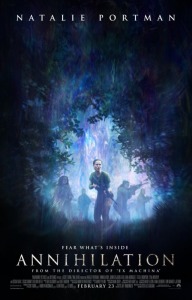 Warning: This review contains major spoilers.
Warning: This review contains major spoilers.
An ambitious and overwhelming tale of biological hybrids and a cinematic hybrid itself, a curious case of Apocalypse Now-meets-Under the Skin, Alex Garland’s sci-fi horror film Annihilation, a Netflix exclusive outside of North America and China, is something of a masterpiece. Based on the eponymous novel by Jeff VanderMeer, Garland’s sophomore directing effort expands upon the subdued, slow-burning intensity of his 2015 debut, the brilliant Ex Machina, and fully commits to the idea that in some stories, suggestiveness, abstraction, and open questions trump neat resolutions.
Plenty of commentators take issue with what Garland has attempted here (just take a look at the IMDb reviews), with some criticising the film for its supposed failings as an adaptation while others dwell on what they perceive to be immersion-breaking plot holes. Some also make more valid points, mainly highlighting issues with the script, which is fair enough: its language is functional, steely and stylised, which works a treat in some instances but jars in others.
But here’s what strikes me after three viewings of this extraordinary movie: I don’t care. I recognise that on a purely technical level, there are reasonable debates to be had on the relative merits of Annihilation (even though I stand by my claim that its alleged weak spots are few and far between). But to my mind, the vision and the sheer depth of the ideas Garland brings to this project – and the discussions about metaphors and symbolism they inspire – outweigh the details one might fuss over. As I’ve noted elsewhere, you can tell the best films by the writing they inspire, and Annihilation definitely belongs in that class, as evidenced by the excellent pieces from Priscilla Page, Angelica Jade Bastién, and Film Crit Hulk, which you should go read once you’re done with this review.
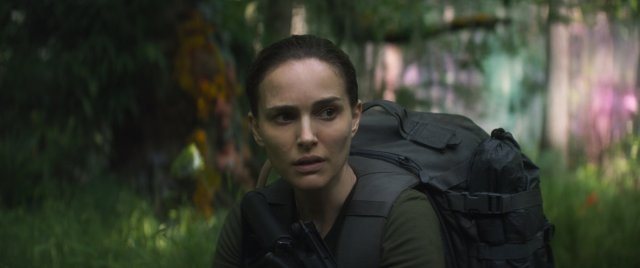
The movie follows the journey of Lena (Natalie Portman), a biology professor at Baltimore’s Johns Hopkins University. A year earlier, her husband Kane (Oscar Isaac) took part in a covert military operation and disappeared without a trace. But as Lena is repainting their bedroom to the doleful sound of Annihilation‘s pop leitmotif, Crosby, Stills & Nash’s “Helplessly Hoping,” Kane enters the house – distant, changed, other. They sit together awkwardly, he starts coughing up blood.
On their way to the hospital, their ambulance is taken over by a black-ops team and they are brought to a military site, where Kane is put into a coma. Lena, meanwhile, meets psychologist Dr. Ventress (an icily creepy Jennifer Jason Leigh), who gives her a rundown of her situation: she is in Area X, a secret research facility near the coast of Louisiana dedicated to the study of a phenomenon called “the Shimmer” – a soapy haze emanating outwards from a lighthouse, claiming ever more land as it expands. (The distorted vista of the treeline just inside its boundaries reminded me of the walking Spider’s Web Forest in Kurosawa’s Throne of Blood.) The thinly populated marshland has been evacuated under the pretext of a chemical spill; the government struggles to understand what is happening. None of those who were sent in to investigate came back – none except Kane.
In order to find out what happened to her husband, Lena joins a team of scientists who are about to venture into the Shimmer: there’s Ventress, paramedic Anya (Gina Rodriguez), geologist Cass (Tuva Novotny), and physicist Josie (Tessa Thompson). Their goal is to reach and solve the mysteries of the lighthouse.
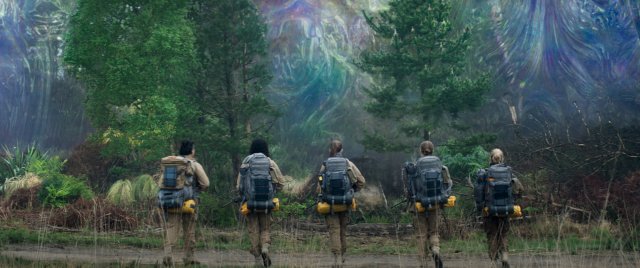
In very broad terms, Annihilation is about life, death, and the acts of self-destruction in between, the corrosion that turns the former into the latter. In one of the film’s central and most talked-about pieces of dialogue, Ventress notes that “almost none of us commit suicide, whereas almost all of us self-destruct.” It’s a strong, haunting theme that echoes throughout the story, one whose narrative manifestations range from literal suicide to painful memories, cycles of toxic behaviour, and even processes on the molecular level. After all, embedded within self-destruction, there is the promise of life: some people harm themselves to combat the numbness of depression while cells eat themselves to prolong their lifespan.
In the Shimmer, this fascinating, all-pervasive ambiguity is actualised. The five scientists, now cut off from outside communication, find plants stuck in continuous mutation, innumerable types of flowers blooming from one single stem – vegetation sampling and discarding different forms, evolution gone haywire. There is a constant presence of colourful lichen and fungi, growing like cancerous cells. Josie is attacked by an albino alligator with concentric rows of teeth, as if it had been crossbred with a shark.
As our protagonists head deeper into the mystery of the Shimmer, we learn more about them. “We’re all damaged goods here,” Cass tells Lena. Josie suffers from depression, Anya is a recovering alcoholic, Ventress – as is revealed later on – is dying of cancer, Cass herself lost a daughter to, notably, leukaemia – a disease, believed to be partly genetic, which corrupts white blood cells, rendering them incapable of effectively protecting the body from infections.

And then there’s Lena – grieving, yes, but also regretting. As the film goes on, more of her past is revealed: her emotional and intellectual connection to Kane had waned even before his disappearance. She had been having an affair with a work colleague (David Gyasi). Perhaps the saddest moment of the film is a flashback to her and Kane sitting on their sofa, him reading a magazine, her Rebecca Skloot’s non-fiction book The Immortal Life of Henrietta Lacks (about the immortal cell line derived from the cervical cancer cells of Henrietta Lacks, who died in 1951 at 31). He looks up, says “Hey,” and they gaze at each other, a deep melancholy evident in both of their faces, a mutual understanding that their love may have already petered out. “Almost all of us self-destruct,” says Ventress, and elaborates, “We drink, or take drugs, or destabilise the happy job, or the happy marriage. But these aren’t decisions. They’re impulses.”
There is a strain of cellular determinism in this movie – the idea that there is no free will because everything that happens in the universe is governed by processes on the atomic and subatomic levels. But luckily, Garland doesn’t get bogged down in overly theoretical metaphysics. Rather, in collaboration with DP Rob Hardy, he finds the terrible beauty inherent in this view – the beauty of destruction, unmaking, and annihilation, one of whose definitions is, after all, “the conversion of matter into energy.”
When Lena, in the frame narrative, describes her time in the Shimmer as “dreamlike,” her interrogator (Benedict Wong) interprets it as “nightmarish.” But Lena insists that “sometimes it was beautiful.” The visuals inside the Shimmer are spectacular: the colours are vivid and full, the plant and fungal creations both gorgeous and unsettling. In an abandoned military outpost, Lena and her colleagues find a memory card containing a video of Kane cutting open a fellow soldier with a knife to reveal his intestines moving like giant worms. They find the man’s body in a nearby room, ripped open, torn apart, skull exposed and locked in a silent scream, fungi, lichen, and flowery mildew blossoming from his insides. Not only is the image, a potential Grateful Dead homage, both shocking and profoundly beautiful – it also serves as a powerful visualisation of natural death: slow, steady, and eerily, ruthlessly productive.
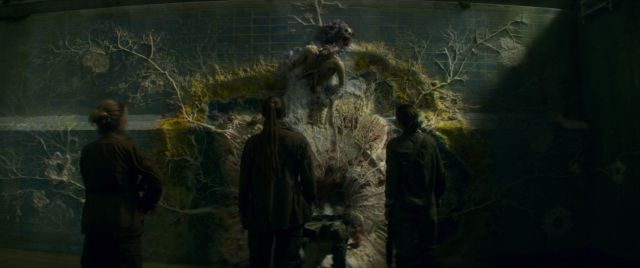
And still, the scientists persist. Cass is carried off by a bear. Lena finds her body the next day. Her, Ventress, Josie, and Anya make their way to an evacuated village, now populated by trees in the shape of people. Again, the image is startling but magical in a way. Inspired by the sight, it’s Josie who finally hits upon the biological mystery of the Shimmer: like a prism refracts light, it refracts DNA, mixing and mutating the genes of every living thing inside it – the trees are imbued with the genes responsible for the human body structure. The Shimmer truly is a “blind watchmaker,” fashioning bizarre organisms out of the living scraps caught within it: Anya feels her skin moving; a tattoo – a figure-eight-shaped ouroboros, the snake eating its own tail – appears, seemingly at random, on people’s forearms.
As all life disintegrates, so does the group, eventually. Its four remaining members make camp in an overgrown house – its interior a derelict copy of Lena and Kane’s home, a subtle, barely acknowledged reference to Lena’s personal brand of self-destruction. During the night, Anya is overtaken by her growing frustration and paranoia and ties up her colleagues. As she is about to attack them, cries of help are heard outside – in Cass’ voice.
But the Shimmer has not revived as much as repurposed her: the bear who attacked and killed her enters the house, its head deformed and hardly covered by fur or skin, a human skull grafted into its side. Whenever the beast opens its mouth, Cass’ dying screams escape from it – an existential horror that has rightly been compared to the nightmares of Cronenberg, Lynch, and Lovecraft, as well as a perverse invocation of Pythagoras, whose theory of reincarnation famously revolved around him recognising the voice of a departed friend in a dog’s bark. In a film that prominently deals with all the ways in which the past comes back to haunt us, this uncanny return of the dead is by far the most visceral moment, a striking culmination of theme perfectly integrated into an expertly realised scene of suspenseful genre cinema.
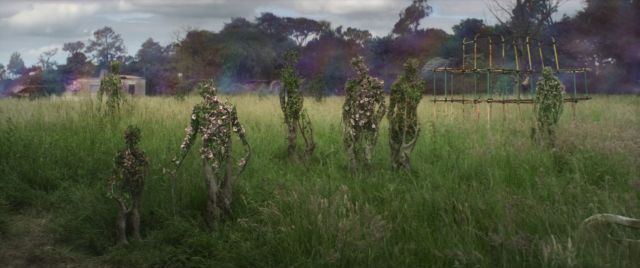
It is also the narrative’s final turning point, which leaves Anya dead, Ventress isolated – she decides to push on to the lighthouse alone – and Josie tired and ready to embrace the Shimmer, leading to yet another haunting, achingly beautiful shot: for the first time, Josie jettisons her jacket to reveal her arms, densely scarred with marks of self-harm, from which greenery starts to sprout. In a truly dreamlike moment, Lena runs after her, unable to catch her, and just like that, Josie is gone – swallowed by scenery, remade into vegetation. Recalling Darren Aronofsky’s underrated The Fountain (2006), her fate intriguingly blurs the lines between the differing ways we frame death: does she commit suicide, or is it a surrender, a well-earned state of peace, or a return into the warm embrace of Gaia? The result, in any case, is the same: Josie has vanished, her matter transformed.
And so we find Lena alone at the beach, surrounded by tree-like crystal structures, venturing into the “heart of darkness” – the lighthouse (whose literary connection to Virginia Woolf’s novel To the Lighthouse is insightfully discussed in Josephine Livingstone’s brilliant article). Inside the building, which is enveloped by chalky, root-like growths, a charred body and a video camera resolve the mystery of Kane’s return: via video footage, we learn that Kane killed himself and charged a doppelgänger – the Kane we saw at the beginning – to find Lena. Thus, the significance of “Helplessly Hoping” – a song chronicling Stephen Stills’ break-up with Judy Collins – begins to take shape: “They are one person / They are two alone / They are three together.”
But Lena is not done. She climbs through a hole in the ground – a reverse birth of sorts – into what we might call a visualisation of the subconscious, a black, glowing, vaguely pulsating room, which, metaphorically at least, is reminiscent of the Bates Motel cellar and Under the Skin‘s darkroom of no return. Here, we rejoin Ventress, faceless at first, muttering cosmic ravings: “It’s the last phase. Vanished into havoc. Unfathomable mind. Now beacon. Now sea.” This is Annihilation‘s spin on Kurtz’s “The horror, the horror,” but, being true to form, what follows is not death but transformation: the alien presence (“It’s not like us; it’s unlike us”) that caused the Shimmer appears to be inside Ventress now, its motives as unclear as ever (“I don’t know what it wants, or if it wants”). Shortly after, the team leader erupts into blinding light and leaves behind a hypnotising, radiant mandelbulb – a three-dimensional fractal.
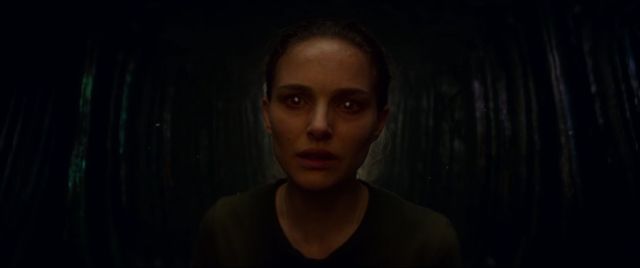
With this, Garland tries his hand at his own version of Kubrick’s “Beyond the Infinite” sequence from 2001: A Space Odyssey (1968) – and pulls it off marvellously. A long shot of the structure’s glowing, psychedelic insides is followed by it fashioning a drop of Lena’s blood into a dark, featureless humanoid figure – another image the film seems to borrow from Under the Skin. Lena escapes back up the way she came – rebirth this time – only to find the thing standing there, mirroring her every move. There’s no hostility in its deliberate movements, which are choreographed to perfection by modern dance artist Bobbi Jene Smith, but rather a sense of childlike inquisitiveness. Only when Lena tries to exit the lighthouse does the figure go on the offensive, pinning her against the closed door and pressing itself onto her.
While this presence, which eventually becomes Lena’s double, is pivotal to the final act, what exactly it represents will ultimately hinge on the reading the viewer prioritises – in keeping with the lighthouse symbolism (again, read the Livingstone piece). The figure, which is played by Sonoya Mizuno (known for her role as Oscar Isaac’s servant and dance partner Kyoko in Ex Machina), can be read as a physical manifestation of people’s “dark half,” their shadow self, the part of the human psyche prone to self-destruction. It can be the suffocating reality of depression. Or you can remain on the literal level and enjoy the scene for what it appears to show – a newly-born alien being latching onto the first organism it perceives (maybe), replicating the familiar process of offspring-parent imprinting.
Whichever interpretation you end up choosing – if you do choose – it makes little difference to the quality of the film. Garland is savvy enough to know that works like Annihilation suffer from any attempt at objectively “solving” them. The sheer strangeness of the set-up ensures that any authoritative resolution would only end in disappointment. Like the best of its kind – 2001 and Under the Skin immediately come to mind – this movie holds on to its share of open questions and unresolved ambiguities, making itself all the more intriguing and ripe for discussion. The only bottom line is that there is no bottom line.

This is what Annihilation is about. It deals with personal trauma and self-destruction and sets them, without diminishing their emotional weight in any way, against the cruel cosmic logic of life and death – that one cannot exist without the other, that one follows from the other, that the cell survives while the body dies, that Henrietta Lacks has been dead for 67 years while her cancer lives on. Even more cruelly, none of this is subject to any kind of rhyme or reason, let alone anything as human as will. The screaming bear, bone-chilling and brutal as it may be, holds no grudge against Cass or Anya. The alligator that nearly kills Josie isn’t evil. Neither is cancer, or leukaemia. They are aimless aberrations on the molecular level, “a failed experiment in mutation,” as a character in John Green’s novel The Fault in Our Stars puts it – meaningless in the grand scheme of things, catastrophic on a personal scale.
There is a flipside to all of this, however. Because even though the film is often foregrounding the relentless and fatal progression of life, the constant “conversion of matter into energy,” it also serves as a stark reminder that we do contain multitudes. Of course, we know that this is biologically true, but Annihilation makes a point of going beyond that: as the Shimmer is making and unmaking organisms, people constantly shift, refocus, and scrap entire aspects of their lives. Lena was a soldier before she was a professor. Cass admits to having been a completely different person before the death of her daughter. Anya is sober, and has therefore succeeded in remaking herself. The conclusion Lena draws at the end of her interrogation is telling: when Benedict Wong’s character argues that the alien presence, now seemingly burned out of existence, “was destroying everything,” she rebuts, “it wasn’t destroying. It was making something new.” As we know from Cléo from 5 to 7 (1962) and every cinematic tarot reading that followed, every change is a kind of death – and every death begets new life, not just biologically, but metaphorically as well.
So yes, I truly don’t care whether the dialogue is slightly off in certain places or whether the film fails to unerringly trick you into suspending your disbelief at every single moment. With Annihilation, Alex Garland has crafted a profound, richly textured, and indescribably beautiful movie. Few 2018 productions, if any, will be able to rival its thematic complexity or its confidence of vision. I couldn’t nitpick it if I tried.
★★★★★ (out of five)
–––––
For more reviews (in German), visit facingthebittertruth.com.
